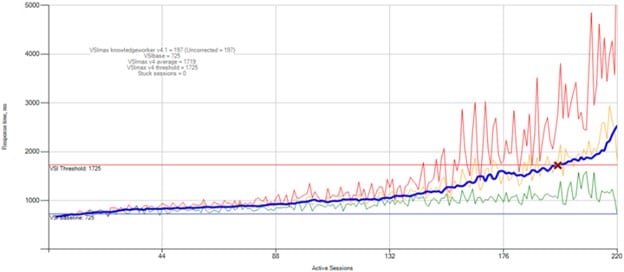Comparing VSImax between Legacy Login VSI and Login Enterprise
June 18, 2024
VSImax is a performance metric that indicates the maximum number of virtual user sessions a VDI environment can handle before desktop responsiveness degrades to an unacceptable level.
Included in our legacy Login VSI test suite and our current Login Enterprise test platform, VSImax is a straightforward measure that helps assess system scalability and identify bottlenecks. As virtual users log onto a system and start performing their workload, the load on the respective system increases, causing the system to slow down when it reaches maximum resource capacity or performance bottleneck.
This article will cover the differences in VSImax between the two products and why our customers may see differences in capacity when testing with Knowledge Workers and Task Workers.

Figure 1 – Legacy Login VSI Test Results showing VSImax

Figure 2 – Login Enterprise Test Results showing VSImax
What are some of the factors that may cause a difference in capacity?
In general, factors that may cause a difference in capacity between Login VSI and Login Enterprise include the operating system, applications, services, infrastructure, and general guidance based on our experience.
It is important to remember that legacy Login VSI was commercially released in 2012, over 12 years ago, when Windows 7 was still the most popular OS in VDI.
So much has changed.
Windows Operating Systems, Application Services, and Security Services
With each new release and patch, the Windows Client and Server OS typically require more resources as more files, applications, and services are added.
These services can create additional resource utilization, especially when logging in. One example is Microsoft’s AppX Deployment Service (AppXsvc, wsappx), which briefly uses considerable CPU resources to register, update, and prepare these apps.
Optimizing a Windows image used to be common, and it still is. However, with many of the reference architectures released by our vendors, disabling services like antivirus and Windows Search Indexing was also the norm to get the most capacity out of the solution.
Knowing just how much you can squeeze out of a particular infrastructure is helpful. Still, the enterprises that implement these solutions in production require some of these critical services to be running to make employees most productive.
While you may see higher capacities from testing conducted years ago, the changes to Windows OS and the added services impact overall capacity for both legacy Login VSI and Login Enterprise.
Applications Used in the Virtual User Workload
When legacy Login VSI was actively used, Microsoft Office 2013 and 2016 were the most common productivity suites. Currently, Office 365 is the most common and is the basis for the Login Enterprise Task and Knowledge Workers. Many features have been added to the Office suite between Office 2013 and Office 365 that will drive more resource utilization.
Aside from Microsoft Office, the “timers” and default applications used to determine the desktop’s responsiveness are pretty different. These timers or metrics have evolved to represent a more modern worker, so the legacy Login VSI timers did not use as many resources as the latest Login Enterprise EUX Score timers.
Our research typically sees two main drivers of resource utilization on standard knowledge worker desktops: browsers and unified communications platforms.
In other words, Microsoft Edge, Google Chrome, and Microsoft Teams. Legacy Login VSI uses Internet Explorer as the browser for its Knowledge Worker workload, while Login Enterprise supports Edge, Chrome, and Firefox.
These modern browser applications are known for being resource intensive, while Internet Explorer was not and is no longer supported by Microsoft. Browser resource utilization is critical in Legacy Login VSI and Login Enterprise capacity differences.
Practical Capacities in Production Environments
During the development of Login Enterprise, we conducted user experience trials with real human users and loaded systems to determine when the user would experience a slowdown that impacted their productivity. We also worked with many of our production enterprise customers to gather feedback on their actual server user capacities to ensure our VSImax represented a realistic threshold for maximum capacity.
While this work is still in progress, general feedback is that the capacities reported by legacy Login VSI were considerably higher than those achieved in modern enterprise production VDI environments. To that end, we have set our VSImax trigger profiles to best represent a more realistic capacity. This work is called EUX Profiles, and if you’d like to offer feedback, please add it to our feature request portal at https://feedback.loginvsi.com.
What can we expect to see as a difference in VSImax capacities?
While some testing has been done to compare the two products on the same infrastructure, very little formal data is available comparing the same environment with Legacy Login VSI and Login Enterprise.
Based on our research, we expect about a 40% to 50% drop in capacity when comparing legacy Login VSI to Login Enterprise, a consistent finding across most of the studies conducted by our industry vendors in the VDI market.
Keep in mind that capacities will vary between our legacy product and our latest product. If you have any questions or concerns, please contact us. To see the latest reference architecture using Login Enterprise click here.
Not yet a Login VSI customer? Learn more about automated performance and scalability testing for images, applications, and desktops! Talk to an expert today.
BenchmarksLifecycle OptimizationLogin Enterprise ReleaseWindows 10



